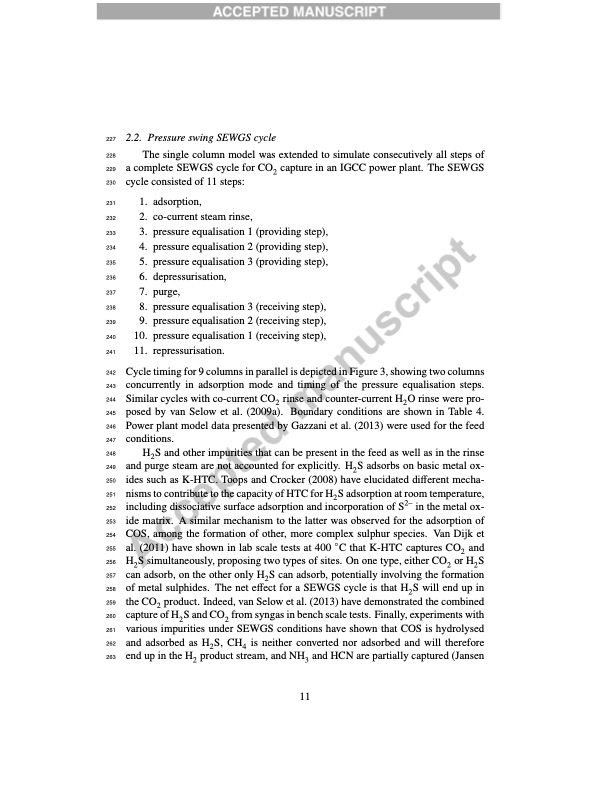
PDF Publication Title:
Text from PDF Page: 013
227 2.2. Pressure swing SEWGS cycle 228 The single column model was extended to simulate consecutively all steps of 229 a complete SEWGS cycle for CO2 capture in an IGCC power plant. The SEWGS 230 cycle consisted of 11 steps: 231 1. adsorption, 232 2. co-current steam rinse, 233 3. pressure equalisation 1 234 4. pressure equalisation 2 235 5. pressure equalisation 3 236 6. depressurisation, 237 7. purge, 238 8. pressure equalisation 3 239 9. pressure equalisation 2 240 10. pressure equalisation 1 241 11. repressurisation. 242 Cycle timing for 9 columns in 243 concurrently in adsorption mode and timing of the pressure equalisation steps. 244 Similar cycles with co-current CO2 rinse and counter-current H2O rinse were pro- 245 posed by van Selow et al. (2009a). Boundary conditions are shown in Table 4. 246 Power plant model data presented by Gazzani et al. (2013) were used for the feed 247 conditions. 248 H2S and other impurities that can be present in the feed as well as in the rinse 249 and purge steam are not accounted for explicitly. H2S adsorbs on basic metal ox- 250 ides such as K-HTC. Toops and Crocker (2008) have elucidated different mecha- 251 nisms to contribute to the capacity of HTC for H2S adsorption at room temperature, 252 including dissociative surface adsorption and incorporation of S2– in the metal ox- 253 ide matrix. A similar mechanism to the latter was observed for the adsorption of 254 COS, among the formation of other, more complex sulphur species. Van Dijk et 255 al. (2011) have shown in lab scale tests at 400 ◦C that K-HTC captures CO2 and 256 H2S simultaneously, proposing two types of sites. On one type, either CO2 or H2S 257 can adsorb, on the other only H2S can adsorb, potentially involving the formation 258 of metal sulphides. The net effect for a SEWGS cycle is that H2S will end up in 259 the CO2 product. Indeed, van Selow et al. (2013) have demonstrated the combined 260 capture of H2S and CO2 from syngas in bench scale tests. Finally, experiments with 261 various impurities under SEWGS conditions have shown that COS is hydrolysed 262 and adsorbed as H2S, CH4 is neither converted nor adsorbed and will therefore 263 end up in the H2 product stream, and NH3 and HCN are partially captured (Jansen 11 (providing step), (providing step), (providing step), (receiving step), (receiving step), (receiving step), parallel is depicted in Figure 3, showing two columnsPDF Image | High-temperature pressure swing adsorption cycle design for sorption

PDF Search Title:
High-temperature pressure swing adsorption cycle design for sorptionOriginal File Name Searched:
high-temperature-pressure-swing-adsorption.pdfDIY PDF Search: Google It | Yahoo | Bing
CO2 Organic Rankine Cycle Experimenter Platform The supercritical CO2 phase change system is both a heat pump and organic rankine cycle which can be used for those purposes and as a supercritical extractor for advanced subcritical and supercritical extraction technology. Uses include producing nanoparticles, precious metal CO2 extraction, lithium battery recycling, and other applications... More Info
Heat Pumps CO2 ORC Heat Pump System Platform More Info
| CONTACT TEL: 608-238-6001 Email: greg@infinityturbine.com | RSS | AMP |